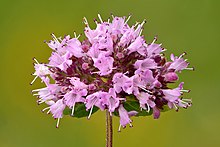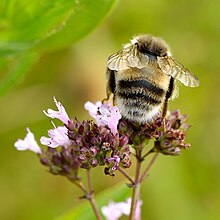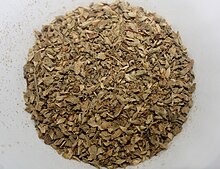Oregano
| Oregano | |
|---|---|

| |
| Scientific classification | |
| Kingdom: | Plantae |
| Clade: | Tracheophytes |
| Clade: | Angiosperms |
| Clade: | Eudicots |
| Clade: | Asterids |
| Order: | Lamiales |
| Family: | Lamiaceae |
| Genus: | Origanum |
| Species: | O. vulgare
|
| Binomial name | |
| Origanum vulgare | |
Oregano(US:/ɔːˈrɛɡənoʊ,ə-/,[1]UK:/ˌɒrɪˈɡɑːnoʊ/;[2]Origanum vulgare) is a species offlowering plantin themint familyLamiaceae. It was native to theMediterranean region,but widely naturalised elsewhere in thetemperateNorthern Hemisphere.
Oregano is a woodyperennial plant,growing 20–80 cm (8–31 in) tall, withopposite leaves1–4 cm (1⁄2–1+1⁄2in) long. The flowers which can be white, pink or light purple, are3–4 mm (1⁄8–3⁄16in) long, and produced in erect spikes in summer. It is sometimes calledwild marjoram,while its close relativeO. majoranais known as sweet marjoram. Both are widely used asculinary herbs,especially in Turkish, Greek, Spanish, Italian, Hispanic, and French cuisine. Oregano is also anornamental plant,with numerouscultivarsbred for varying leaf colour, flower colour and habit.
Etymology[edit]
Used since the middle 18th century, the Spanish wordoréganois derived from theLatinorīganumwhich itself comes fromClassical Greekὀρίγανον(orī́ganon).[3]The ultimate origin is disputed; some claim it is a compound Greek term that consists ofὄρος(óros) meaning "mountain", andγάνος(gános) meaning "joy", thus, "joy of the mountain"[3]whileThe Oxford English Dictionarystates it is "probably a loanword [as] the plant comes from Africa",[4]and that "joy of the mountain" is afalse etymology.
Description and biology[edit]

Oregano is related to the herbmarjoram,sometimes being referred to as wild marjoram. It has purple flowers and spade-shaped, olive-green leaves. It is a perennial,[5][6]although it is grown as an annual in colder climates, as it often does not survive the winter.[7][8] Oregano is planted in early spring, the plants being spaced 30 cm (12 in) apart in fairly dry soil, with full sun. It will grow in a pH range between 6.0 (mildly acidic) and 9.0 (strongly alkaline), with a preferred range between 6.0 and 8.0. It prefers a hot, relatively dry climate, but does well in other environments.[9]
Taxonomy[edit]




Many subspecies and strains of oregano have been developed by humans over centuries for their unique flavours or other characteristics. Tastes range from spicy or astringent to more complicated and sweet. Simple oregano sold in garden stores asOriganum vulgaremay have a bland taste and larger, less-dense leaves, and is not considered the best for culinary use, with a taste less remarkable and pungent. It can pollinate other more sophisticated strains, but the offspring are rarely better in quality.
The related speciesOriganum onites(Greece, Turkey) andO. syriacum(West Asia) have similar flavours. A closely related plant is marjoram from Turkey, which differs significantly in taste becausephenolic compoundsare missing from its essential oil. Some varieties show a flavour intermediate between oregano and marjoram.
Subspecies[edit]
Accepted subspecies:[10]
- O. v.subsp.glandulosum(Desf.) Ietsw.–Tunisia,Algeria
- O. v.subsp.gracile(K.Koch) Ietsw.(=O. tyttanthum) has glossy green leaves and pink flowers. It grows well in pots or containers, and is more often grown for added ornamental value than other oregano. The flavor is pungent and spicy.[11]– Central Asia,Iran,India,Turkey,Afghanistan,Pakistan.
- O. v.subsp.hirtum(Link) Ietsw.– (Italian oregano, Greek oregano) is a common source of cultivars with a different aroma[11]from those ofO. v. gracile.Growth is vigorous and very hardy, with darker green, slightly hairy foliage. Generally, it is considered the best all-purpose culinary subspecies. –Greece,Balkans, Turkey,Cyprus
- O. v.subsp.virens(Hoffmanns. & Link) Ietsw.–Iberian Peninsula,Macaronesia,Morocco
- O. v.subsp.viridulum(Martrin-Donos) Nyman– widespread fromCorsicatoNepal
- O. v.subsp.vulgare– widespread across Europe + Asia fromIrelandtoChina;naturalized in North America +Venezuela
Cultivars[edit]
Examplecultivarsof oregano include:
- 'Aureum' – golden foliage (greener if grown in shade), mild taste: It has gained theRoyal Horticultural Society'sAward of Garden Merit[12]
- 'Greek Kaliteri' –O. v.subsp.hirtumstrains/landraces,small, hardy, dark, compact, thick, silvery-haired leaves, usually with purple undersides, excellent reputation for flavor and pungency, as well as medicinal uses, strong, archetypal oregano flavor (Greekkaliteri:the best)
- 'Hot & Spicy' –O. v.subsp.hirtumstrain
- 'Nana' – dwarf cultivar
Cultivars traded as Italian, Sicilian, etc. are usually hardy sweet marjoram (O.×majoricum), ahybridbetween the southernAdriaticO. v.subsp.hirtumand sweet marjoram (O. majorana). They have a reputation for sweet and spicy tones, with little bitterness, and are prized for their flavor and compatibility with various recipes and sauces.
Uses[edit]
This sectionneeds additional citations forverification.(November 2017) |
Culinary[edit]

Oregano is aculinary herb,used for the flavour of its leaves, which can be more intense when dried than fresh. It has an earthy, warm, and slightly bitter taste, which can vary in intensity. Good-quality oregano may be strong enough to almost numb the tongue, but cultivars adapted to colder climates may have a lesser flavour. Factors such as climate, season, and soil composition may affect the aromatic oils present, and this effect may be greater than the differences between the various species of plants. Among the chemical compounds contributing to the flavour arecarvacrol,thymol,limonene,pinene,ocimene,andcaryophyllene.[13]
Oregano is the staple herb ofItalian cuisine,most frequently used with roasted, fried, or grilled vegetables, meat, and fish. Oregano combines well with spicy foods popular inSouthern Italy.It is less commonly used in the north of the country, as marjoram is generally preferred. Its popularity in the U.S. began when soldiers returning fromWorld War IIbrought back with them a taste for the "pizza herb", which had probably been eaten in Southern Italy for centuries.[14]
Oregano is widely used incuisinesof theMediterranean BasinandLatin America,especially inMexican cuisineandArgentine cuisine.In Turkish cuisine, oregano is mostly used for flavouring meat, especially mutton and lamb. In barbecue andkebabrestaurants,[clarification needed]it can be usually found as acondiment,together withpaprika,salt, and pepper.
During the summer, generous amounts of dried oregano are often added as a topping to a tomato and cucumber salad inPortugal,but it can be used to season meat and fish dishes as well. InSpain,apart from seasoning, it is used in preparations of a variety of traditional dishes such asmorcilla(Iberian pig blood sausage) andadobosauce for fish and meat. The dried and ground leaves are most often used in Greece to add flavour toGreek salad,and is usually added to the lemon-olive oil sauce that accompanies fish or meat grills and casseroles. In Albania, dried oregano is often used to make herbal tea which is especially popular in the northern part of Albania.
Oregano oil[edit]

Oregano oil has been used infolk medicineover centuries.[11]Oregano essential oil is extracted from the leaves of the oregano plant. Although oregano or its oil may be used as adietary supplement,there is no clinical evidence to indicate that either has any effect on human health.[11][15]
In 2014, the USFood and Drug Administration(FDA) warned aUtahcompany,Young Living,that its herbal products, including oreganoessential oil,were being promoted to have numerous unproven anti-disease effects, and so were being sold as unauthorized misbrandeddrugssubject to seizure and federal penalties.[16]Similar FDAwarning lettersfor false advertising and unprovenhealth claimsabout oregano essential oil products were published in 2017 and 2018.[17][18]
Chemical components[edit]
Oregano containspolyphenols,including numerousflavones.[19][20]
The essential oil of oregano is composed primarily ofmonoterpenoidsandmonoterpenes,with the relative concentration of each compound varying widely across geographic origin and other factors. Over 60 different compounds have been identified, with the primary ones beingcarvacrolandthymolranging to over 80%, while lesser abundant compounds includep-cymene,γ-terpinene,caryophyllene,spathulenol,germacrene D,β-fenchyl alcoholandδ-terpineol.[21]
Drying of the plant material affects both quantity and distribution of volatile compounds, with methods using higher heat and longer drying times having greater negative impact. A sample of fresh whole plant material found to contain 33 g/kg dry weight (3.1 g/kg wet) decreased to below a third after warm-air convection drying. Much higher concentrations of volatile compounds are achieved towards the end of the growing season.[22]
Other plants called "oregano"[edit]
- Coleus amboinicus,known as Cuban oregano,orégano poleo('pennyroyaloregano'),orégano francés('French oregano'), Mexican mint, Mexican thyme, and many other names, is also of the mint family (Lamiaceae). It has large and somewhatsucculentleaves. Common throughout the tropics, including Latin America, Africa, and Southeast Asia, it is probably of eastern-hemisphere origin.
- Lippia graveolens,Mexican oregano, known in Spanish asorégano cimarrón('wild oregano'), is not in the mint family, but in the relatedvervain family(Verbenaceae). The flavor of Mexican oregano has a stronger savory component instead of the piney hint of rosemary-like flavor in true oregano, and its citrus accent might be more aromatic than in oregano. It is becoming more commonly sold outside of Mexico, especially in the southeastern United States. It is sometimes used as a substitute forepazoteleaves.
- Hedeoma patens,known in Spanish asorégano chiquito('small oregano'), is also among the Lamiaceae. It is used as an herb in the Mexican states ofChihuahuaandCoahuila.
- Poliominthalongiflora,common names: Mexican oregano and rosemary mint, is native to Mexico and also grown and used in the U.S.A.
See also[edit]
- Thymus vulgaris,thyme
References[edit]
- ^"American: Oregano".Collins Dictionary. n.d.Retrieved25 September2014.
- ^"British: Oregano".Collins Dictionary.Retrieved25 September2014.
- ^ab"Oregano".Online Etymology Dictionary, Douglas Harper, Inc.Retrieved6 October2016.
- ^Dean, Sam (21 June 2013)."The Etymology of Oregano and Marjoram".Bon Appetit.Retrieved9 October2023.
- ^"Origanum vulgare L. oregano".Plants Database, United States Department of Agriculture.Retrieved30 January2011.
- ^"Growing Culinary Herbs in Ontario".Ontario Ministry of Agriculture, Food & Rural Affairs. Archived fromthe originalon 19 July 2010.Retrieved30 January2011.
- ^Peter, K. V. (2004)."14.3.1 Growth habit of wild oregano populations".Handbook of herbs and spices.Vol. 2. Abington Hall, Abington: Woodhead Publishing Limited. p. 219.ISBN1-85573-721-3.Retrieved30 January2011.
- ^"Herbs".Government of Saskatchewan. September 2009. Archived fromthe originalon 3 October 2011.Retrieved30 January2011.
- ^"Oregano and Marjoram".Ontario Ministry of Agriculture, Food and Rural Affairs, Guelph, Canada. 17 October 2012.Retrieved31 January2017.
- ^"Oregano,Origanum vulgareL. "Kew World Checklist of Selected Plant Families, Royal Botanic Gardens, Kew, Richmond, Surrey, UK. 2017.
- ^abcd"Oregano".Drugs. 2016.Retrieved7 October2016.
- ^"RHS Plant Selector –Origanum vulgare'Aureum'".Retrieved16 January2021.
- ^Mockute, Danute; Bernotiene, Genovaite; Judzentiene, Asta (2001). "The essential oil of Origanum vulgare L. Ssp. Vulgare growing wild in Vilnius district (Lithuania)".Phytochemistry.57(1): 65–9.doi:10.1016/S0031-9422(00)00474-X.PMID11336262.
- ^Martyris, Nina (9 May 2015)."GIs Helped Bring Freedom To Europe, And A Taste For Oregano To America".NPR.Retrieved28 May2018.
- ^"Oregano".MedlinePlus, US National Library of Medicine. 2016.Retrieved7 October2016.
- ^LaTonya M. Mitchell (22 September 2014)."Warning Letter: Young Living".Inspections, Compliance, Enforcement, and Criminal Investigations, US Food and Drug Administration.Retrieved7 October2016.
- ^Ingrid A. Zambrana (25 July 2017)."Warning Letter: Absonutrix".Inspections, Compliance, Enforcement, and Criminal Investigations, US Food and Drug Administration.Retrieved18 May2019.
- ^Kimberly L. McMillan (31 January 2018)."Warning Letter: Long Life Unlimited".Inspections, Compliance, Enforcement, and Criminal Investigations, US Food and Drug Administration.Retrieved18 May2019.
- ^Dragland, Steinar; Senoo, Haruki; Wake, Kenjiro; Holte, Kari; Blomhoff, Rune (1 May 2003)."Several culinary and medicinal herbs are important sources of dietary antioxidants".Journal of Nutrition.133(5): 1286–90.doi:10.1093/jn/133.5.1286.ISSN0022-3166.PMID12730411.
- ^Tair, Asma; Weiss, Erika-Krisztina; Palade, Laurentiu Mihai; Loupassaki, Sofia; Makris, Dimitris P.; Ioannou, Efstathia; Roussis, Vassilios; Kefalas, Panagiotis (2014). "Origanum species native to the island of Crete: in vitro antioxidant characteristics and liquid chromatography–mass spectrometry identification of major polyphenolic components".Natural Product Research.28(16): 1284–7.doi:10.1080/14786419.2014.896011.PMID24635145.S2CID42500633.
- ^Teixeira, Bárbara; Marques, António; Ramos, Cristina; Serrano, Carmo; Matos, Olívia; Neng, Nuno R; Nogueira, José M F; Saraiva, Jorge Alexandre; Nunes, Maria Leonor (2013). "Chemical composition and bioactivity of different oregano (Origanum vulgare) extracts and essential oil ".Journal of the Science of Food and Agriculture.93(11): 2707–14.doi:10.1002/jsfa.6089.PMID23553824.
- ^Figiel, Adam; Szumny, Antoni; Gutiérrez-Ortíz, Antonio; Carbonell-Barrachina, Ángel A. (2010). "Composition of oregano essential oil (Origanum vulgare) as affected by drying method".Journal of Food Engineering.98(2): 240–7.doi:10.1016/j.jfoodeng.2010.01.002.
- "Oregano Essential Oil Uses for Skin, Hair, and Aromatherapy".Gyalabs.Retrieved28 November2022.
